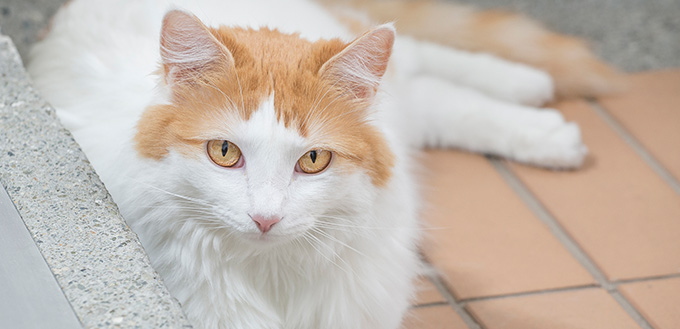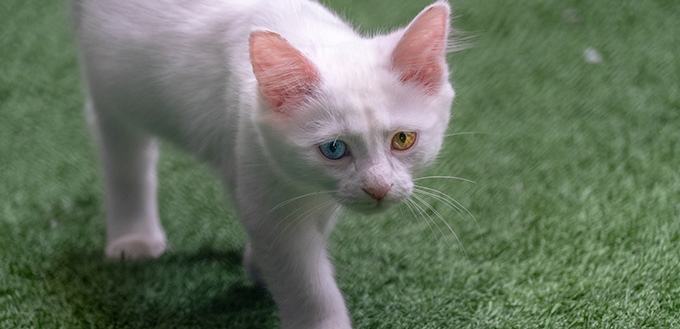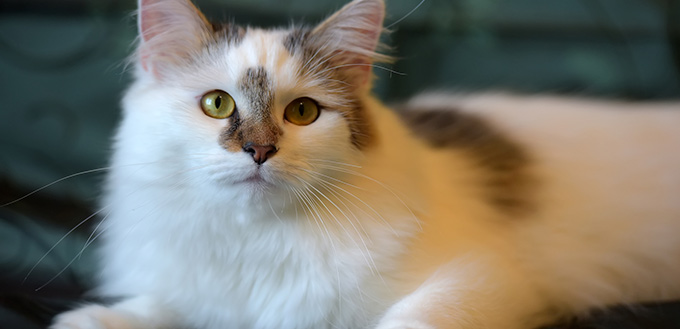Cats can come in all different shapes and sizes from all around the world. For many cat lovers, tracing the fascinating origins of a cat breed is part of the fun of owning a cat. Understanding as much as you can about the history of a breed can help you to learn the best way to take care of them, and you may even learn about new, exotic breeds descended from cats on the other side of the world. This is exactly the case when it comes to the Van Cat, a muscular cat of Turkish origin.

History of the Van Cat
The story of the Van Cat starts in Turkey, specifically near the lake which has given it its name, Lake Van. The modern Van Cat breed descends from cats in this mountainous region. It is believed that these descendants have lived in this region for over 5000 years due to archaeological evidence discovered there. Various decorative items dating back thousands of years have been unearthed in the region, such as carvings and jewelry depicting cats with similar characteristics as the Van Cat. However, it is not known whether they were native to the area, and later domesticated, or if they came to the region when a particular population migrated there.
Regardless, the physical traits of the Van Cat further demonstrate that they have lived in Eastern Turkey for thousands of years. They have long, thick hair in the winter, which they use to survive the long, cold winters in the mountains, but have adapted to shed this fur for hot summers. This both cools them down, and makes it easier to swim in the Lake to cool down. Ultimately, these biological adaptations could further supports the idea that the cat is a native of the Lake Van region.
The first Van Cats appeared in Europe about 1000 years ago, around 1095AD to 1272AD. It is thought that the crusades played a large role in their transport as the wars brought a huge number of soldiers, explorers and traders to the region. Enchanted by the cat’s unique coat, the various visitors and invaders transported them back to Europe as pets and they became known under a variety of names, such as the Ringtail cat or the Eastern Cat. Although the Ringtail was now well known across Eurasia, they wouldn’t be formally bred until the mid-20th century.
The modern breed of the Van Cat can be traced back to 1955, when two British photographers named Laura Lushington and Sonia Halliday, came to Turkey to photograph for the Turkish Ministry of Tourism. During this trip, the women were gifted two Van Cats who were unrelated to one another, while visiting two different locations. On their return to the UK, the two cats bred and produced identical offspring. Lushington surmised that the Van Cat was a purebred.
Lushington then committed to formally breeding the Van Cat and returned to Turkey to find another pair so that they may demonstrate their purebred status further through the production of three generations. In this way, she created a specific standard for the Van Cat, and all registered Van Cats in the West descend from Lushington’s own population. Importing a Van Cat directly from its homeland is almost unheard of as they are considered national treasures and quite rare.
Her standard was recognized in the UK by 1969, and the cat was quickly imported to the USA. Breeding in the US was then taken up by Barbara and Jack Reark in Florida, and the Cat Fanciers Association first registered the breed in 1998. Eventually, the breed gained championship status in 1994. Only approximately 100 Van Cat’s are registered every year, making the breed a relatively rare pet.
Quick Facts About the Van Cat
Now we’ve grasped the complicated history of the Van Cat, we should delve a little bit further into the breed. As it is a fairly rare breed that originates from abroad, the Van Cat is often not very well known or understood. Understanding your cat is essential if you are going to be able to care for it, so let’s start with a few Van Cat fun facts:
- Heterochromia, when an animal has two different eye colors, is quite common in Van Cats. They often have one amber eye and one blue eye. This is much more common in their native country as the western-bred Van Cats were bred to have matching eyes, much to the amusement of the local people around Lake Van.
- The Van Cat has seasonal hair lengths, which makes categorizing them difficult. Officially, they are considered semi-long hairs.
- Regardless of its length, their hair is very soft. Many have compared it to cashmere.
- They only have one coat, and do not have an undercoat. This means that Van Cat kittens appear to be short hairs, and it will take up to 5 years for their coat to grow to full length.
- Their tail and ears do not shed for summer like the rest of their body does. They are always long and fluffy.
- They are most famous for the distinctive pattern of their fur, which is known as the ‘Van pattern’. The pattern is white with color on their tail and the top of their head.
- Van Cats love to swim and their silky coat is water resistant to support this. This means they can dry themselves much faster than other breeds of cat.
- Lushington originally named the Van Cat as the ‘Turkish Cat’, but it was changed to avoid confusion with the Turkish Angora.
- Their love of swimming mean they are often referred to as the ‘Swimming Cats’ in their homeland.

Things You Should Know About the Van Cat
As anyone who has owned multiple breeds of cat will tell you, every breed has specific needs and new cat owners can often underestimate this, particularly when caring for an exotic or rare breed like the Van Cat. Rare or foreign breeds are not inherently more challenging that their native cousins, but it is always worthwhile to do your research to ensure you can provide them with the care and attention they deserve.
Health
Just like humans, cats can have different body types. In order to keep them as healthy as possible, you should make yourself familiar with what a healthy Van Cat looks like. Van Cats are not naturally skinny, nor should they be very chunky. They are large, muscular animals with an athletic build, broad shoulders and short neck. They can weigh up 18 pounds! The average male should weigh around 16 pounds, while a female should be around 13 pounds.
Luckily, as a breed, the Van Cat is in good health. Most Van Cats are not genetically predisposed to any specific health problems. This means you can focus on feeding, grooming and caring for them, without needing additional regular check-ups. Just remember to take them for all their normal veterinary exams and vaccinations.
All-white van cats, however, are a different story. Unfortunately, like many all-white coats, the white Van Cat can suffer from deafness as a result of the gene that makes them colorless. Whether the all-white Van Cat can be considered a Van Cat, as it does not have the Van pattern, is often debated. For some, it is a breed of its own, known as the Turkish Vankedisi.
Regardless of how you catalogue the cat, it is important to care for their ears, know the symptoms of hearing loss in cats, and bring them to regular checkups. You should also ensure you know the cat’s lineage as it is common practice to crossbreed the Turkish Vankedisi with Turkish Van to reduce the risk of hearing problems. If your cat has been crossbred, the risk is not nullified, and you will want to continue caring for their ears, but a cat that has not been crossbred will almost certainly require a little bit of extra care and attention.
Feeding
Feeding your Van Cat should not be significantly different from feeding most other cats. They do not require a unique diet or special supplements. Make sure to feed them plenty of protein, as all cats are carnivores and Van Cats can be particularly active. Kittens will need more protein than cats to support them as they grow. Van Cats generally reach maturity before the age of 5, so it is important to discuss how you can support each stage of their growth with a vet. Van Cats are also prone to obesity, so you must make sure you are not overfeeding them. Automatic feeders for cats will allow you to control your pet’s portion size. If you are ever unsure about your cat’s weight, take them to your veterinarian who can perform a body analysis and offer advice on how to feed them.
Care
Caring for a Van Cat requires daily work as they will not only need feeding, but daily exercise and attention. While they aren’t the cuddliest cats, they do want your attention and you should play with them every day and provide them with toys that they can play with on their own. As they love to climb, climbing towers and scratching posts are essential, but, as an intelligent, hunting breed, they will also appreciate plenty of puzzles and opportunities to chase.
Related Posts: Best Cat Scratching Pads and Best Interactive Cat Toys
Grooming
Van Cats have fairly unique fur as it is long in the winter and short in the summer. It is silky and soft in quality, and is fairly waterproof. You may think that this makes grooming a challenge. However, the silky-smooth nature of their fur actually reduces matting. This means that, although other long-haired cats require daily fur grooming, you should only need to brush your Van Cat once a week, even in winter. However, as with all cats, you may need to increase brushing when they shed their fur seasonally around spring.
Related Post: Best Brush For Cats

Temperament
A cat’s temperament and their history is closely intertwined. However, while working cats are active and lap cats can be sleepy, we can’t be entirely sure why and when Van Cats were first domesticated. It is unlikely that they were used as working cats. It is most likely that they were never formally domesticated in the region, and simply grew tame through living in partnership with local villages and settlements. This means that the biggest influence on their personality is their environment.
Van Cats are very active cats who are used to living a free lifestyle in a mountainous region by a lake. It still has many ‘wild’ traits that can even be compared to a lion. They are protectors and hunters, just as lions are, and their mountainous roots mean they are most comfortable in high places. Van Cats are commonly found on high shelves, watching over their loved ones. Their enjoyment of climbing does put your fragile belongings at risk, so it is a good idea to keep vases and other items inside cupboards and out of reach.
Similarly, their love of water probably stems from their time living near Lake Van. If you have a swimming pool, pond, or live hear a lake, they will enjoy swimming there in summer. However, be careful they don’t try to swim in strong currents. Keep them away from rivers. You should also consider the water sources in your own home. Toilets must be kept closed, both for hygiene purposes and as they pose the risk of drowning if your Van Cat gets stuck. Even if you do not have natural water sources, your Van Cat will enjoy playing with faucets and water basins. Playing with water provides a great opportunity to bond with a Van Cat.
Bonding is important because Van Cats bond closely, and loyally, to their family, which makes them a serious commitment as they will not handle being re-homed and adopted by another family very well. It is not a good idea to get a Van Cat if you cannot guarantee you will be around to care for it for it’s entire lifespan, which can last up to 17 years. While they don’t always enjoy being cuddled for long periods of time, as they prefer watching from a distance, they will often let you know vocally how much they love you, and when they want attention.







